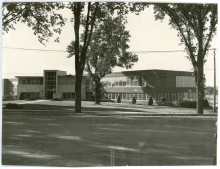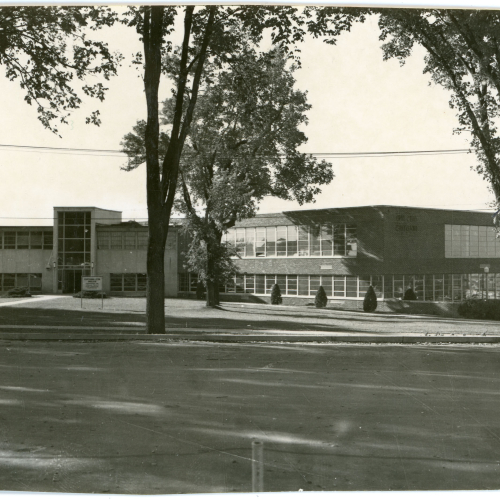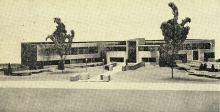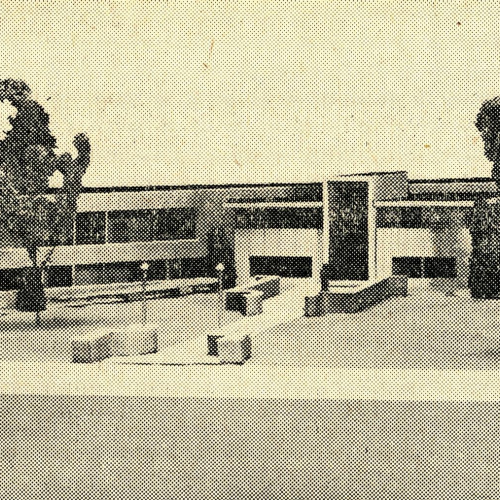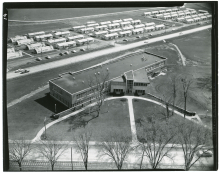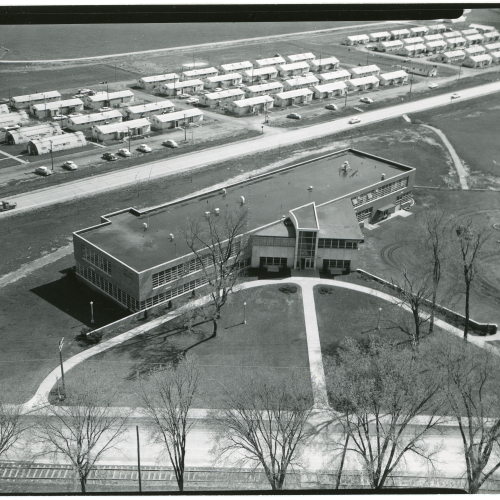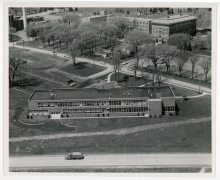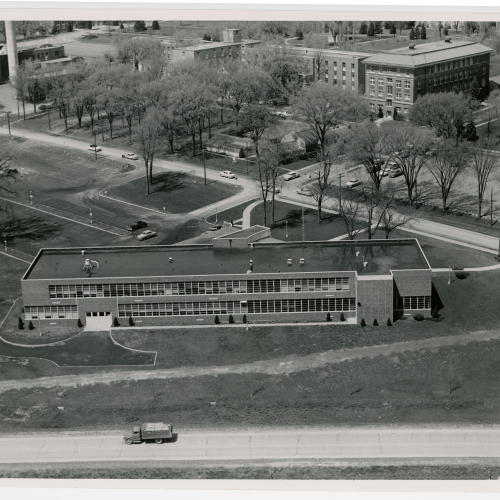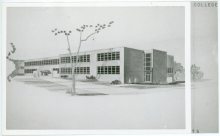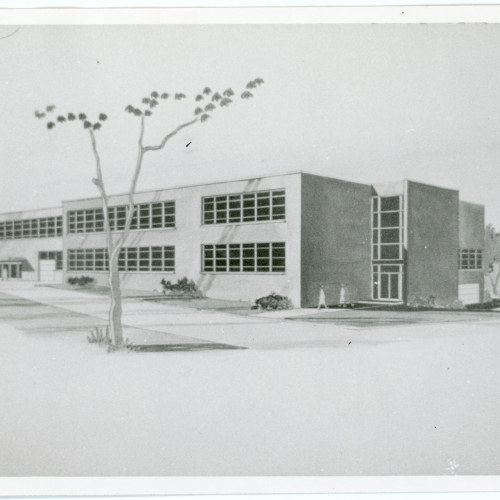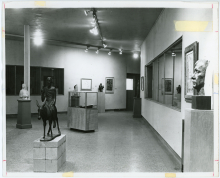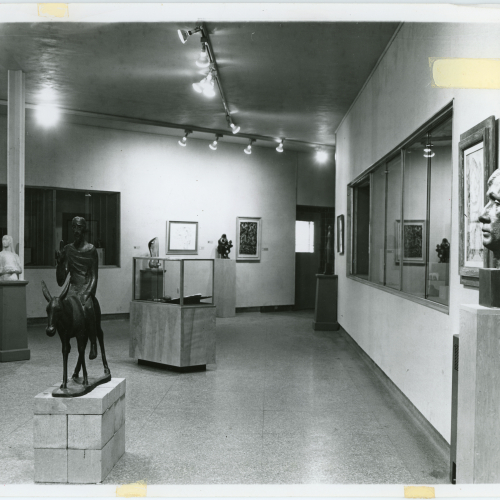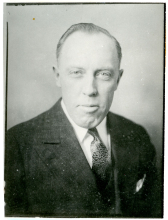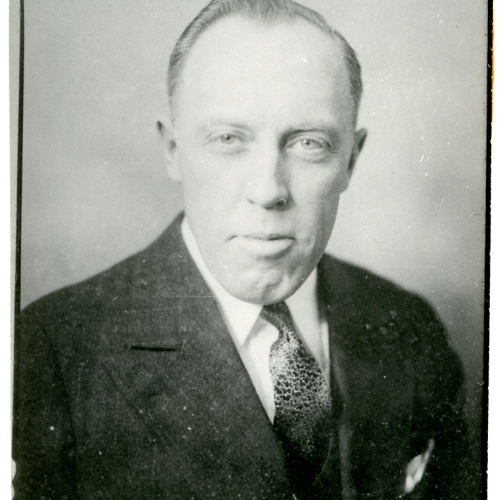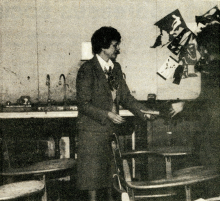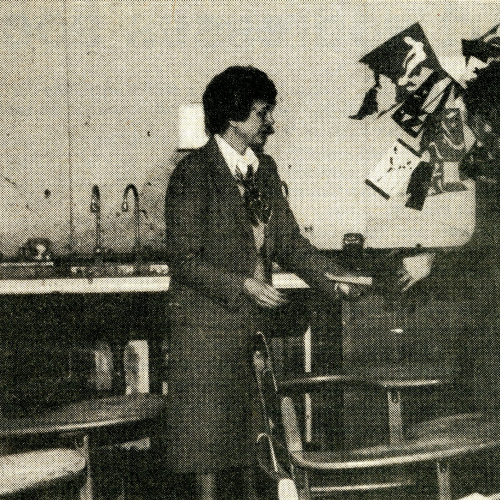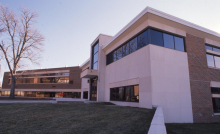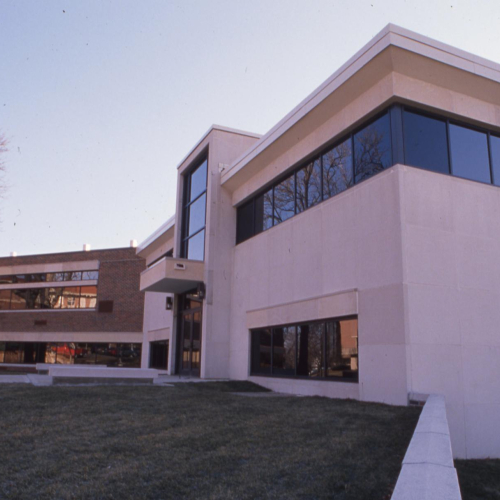Latham Hall (1948)
President Malcolm Price recognized the need for a building purposely designed for art and industrial arts programs at least as early as 1944. As part of a capital improvement plan, he asked the General Assembly for $200,000 for a new art and industrial arts building. He believed that the Vocational Building (now Wright Hall) had inadequate facilities to serve the postwar demand for technical and vocational training. In 1945, the General Assembly appropriated a total of $905,000 for postwar capital improvements on the ISTC campus. Funding was designated for a new laboratory school, a health center, physical plant enhancements, and an Arts and Industries Building. By August 1945, plans for these facilities were in the hands of architects. The two story Arts and Industries Building was to be approximately 240 feet by 60 feet, with the first level devoted to industrial arts and the second floor devoted to art.
However, postwar inflation and building supply shortages did not permit construction to begin immediately. President Price asked for an increase in funding and the legislature responded with a forty percent increase in the $905,000 already appropriated. Because of increased postwar enrollment and the need for more classroom space, the Arts and Industries Building took priority in construction. The now $366,000 project was designed by Morgan and Gelatt Architects of Burlington; Kucharo Construction of Des Moines was the general contractor. The target date for completion was September 1948.
Excavation for the building began on October 11, 1947 and footing work on October 17, 1947. The foundation work was complete by January 1948 but the project stalled until April 1948 when structural steel was finally delivered to the site. By September 1948, the target completion date was moved back to January 1949. Just three art classrooms were ready and little equipment had been delivered by the spring 1949 quarter.
The building, which ended up costing approximately $500,000, was completed by the summer of 1949. It was named the Arts and Industries Building to reflect its function as the home of the two academic departments it housed. One wall of each classroom was lined with windows and the opposite wall featured cabinets and drawers to hold supplies and equipment. Each classroom was designed to be self-sufficient and contained all the necessities for teaching in that room.
Both Harry Guillaume, head of the Art Department, and Harold Palmer, head of the Industrial Arts Department, were enthusiastic about their new facilities. Guillaume said that the new building enabled his department to design new courses and to hire new faculty. He believed that art education at the elementary level was critical to human development. Palmer believed that his new quarters enabled his faculty to prepare citizens for useful lives in an increasingly technical society. His curriculum expanded from just three areas of study to fourteen areas. Gordon O. Wilbur, a visiting expert in industrial arts, found the new building to be one of the finest in the United States.
In 1959, as part of a building program that resulted in Russell Hall, a new health center, and an expanded power plant, the General Assembly appropriated $209,250 for an addition to the Arts and Industries Building. Morgan and Associates of Burlington was again selected as the architect for the work in July 1959, which would include classrooms and a home for the safety education program. Preliminary plans and specifications for the project, now budgeted at $235,000, were approved in February 1960. The addition would be on the south side of the existing building and would be a similar design. The project was completed by September 1961.
The Department of Art and the Department of Industrial Arts (later Industrial Technology) continued to share the Arts and Industries Building until Industrial Technology moved to the new Industrial Technology Center in August 1975. The Department of Art expanded its work into some of the space opened up by the Industrial Technology relocation. Art students Bill Boss and Laurie Harn suggested and then developed a Student Art Gallery in the building. A student committee scheduled both competitive and individual shows in the gallery. In 1976, the Graduate College and Alumni Affairs moved into former Arts and Industries quarters after a $54,000 remodel of the space.
UNI has a longstanding tradition of naming a campus building for each of its presidents. President Latham's name had been attached to O. R. Latham Stadium, but that facility was razed in 1976 following the completion of the UNI-Dome. For several years, no facility carried President Latham's name. On August 26, 1980, the Regents approved the renaming of the Arts and Industries Building to Latham Hall in honor of Orval Ray Latham, president of UNI from 1928 to 1940.
By late 1984, the Kamerick Art Building was nearing completion and the Department of Art relocated there. University administration was then considering what to do with Latham Hall. Consensus seemed to be that it would make a good home for the Department of Earth Science and the Department of Home Economics. The university asked for $3 million to renovate Latham Hall for these two departments but funding was delayed for several years. The building continued to be used for offices of Personnel Services and the Graduate College. Some classrooms were also used but they were in poor condition. Director of Planning Leland Thomson said, "We are trying not to use it, because the building in its present form is not efficient . . . We're just sort of limping along at the present time with the present building."
President Curris made Latham Hall his top priority for capital improvement and in 1987 $3 million was appropriated for the renovation. The project would improve the mechanical, electrical, and HVAC systems as well as make interior and exterior modifications. Bids were let in October 1988, construction began in November 1988, and the work was completed in November 1989. The architects were Grimes, Port, Jones, and Schwerdtfeger of Waterloo. Except for stairways and load-bearing walls, the interior was stripped and re-built into well-lit labs, classrooms, and offices. Deteriorated exterior awnings were removed. Classes were held for the first time in the renovated building in the spring semester of 1990.
Today, Latham Hall is home to the Department of Earth Science, which occupies the first level, and the School of Applied Human Sciences, which occupies the second level.
Compiled by Library Assistant Susan Witthoft and volunteer Julie Peterson; edited by University Archivist Gerald L. Peterson, July 1996; substantially revised by Gerald L. Peterson, September 2002; last updated, March 21, 2012 (GP); photos and citations updated by Graduate Assistant Eliza Mussmann, September 14, 2022; content updated by Graduate Intern Marcea Seible, May 2025.

